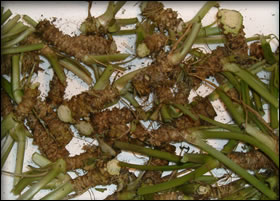 The Scientist: The Scientist:
Will Bignell Third-Year Student (BAgrSc)
School of Agricultural Science,
University of Tasmania
A Grade 12 agricultural science assignment sparked Will Bignell’s passionate research into the growth of wasabi in Tasmania. The assignment was the start of a five-year trial that has the science student exporting wasabi to top Australian restaurants while also completing his third year of an Agricultural Science degree at the University of Tasmania.
A seventh-generation Bothwell farmer, Will has a solid background in the traditional farming aspects of wool and prime lambs and has no plans to leave the land. However, his passion for developing new enterprises and crops has helped his 2000 wasabi trials develop into a business on the side.
Wasabi, a herb used as a garnish or paste in Japanese cuisine, had been grown in soil in Tasmania since the 1990s. Will decided to try growing it in a river on his property because the water was similar to the traditional growing regions of Japan. He conducted extensive literature research and also took advantage of a family holiday in New Zealand to meet researches at Lincoln University and Crop and Food New Zealand..
He then approached the Department of Primary Industry, Water and Environment for seeds and plants and developed the wasabi trial in a space the size of a speedboat on a headrace that was diverted off the river on his home farm.
“The aim of the trials was to try and mimic the traditional graded river gravel beds that are used in Japan,” Will says.
“The water is crucial to having a successful crop. It has to be between 8 – 13 degrees Celsius and very clean. If the temperature rises too high then disease creeps in and over a couple of months will decimate the crop. Disease is a major issue for the whole Tasmanian Industry and we are trying to develop growing systems that minimise the chance of disease occurring.”
Having worked the family farm for a year before beginning his degree, Will believes he has an understanding of the many challenges and opportunities available to farmers. For this reason, he sees a lot of career opportunities for himself and other agricultural science students.
“Agricultural Science is not about how to gather sheep or plough a paddock quicker. It’s more to do with the collection of cutting edge science and then applying it to develop more sustainable production systems for the food and fibre that modern day society demands.”
“There are also plenty of major companies in Tasmania in need of scientific technical personnel and lots of opportunities for work placements in agricultural science for both high school students and university students so that they can get a feel for the industry.”
For now, Will plans to continue his degree and wasabi production, while planning to later focus on wool and meat production on the farm. “I plan to head home to my family farm, but would like to use my degree to work in Industry for a few years before heading home, there are heaps of opportunities in Ag.”

wasabi plants


More about the Work:
Key words: Wasabi, Brassicaceae, nutrient requirements
Wasabi is a perennial herb belonging to the same family of plants as broccoli, cabbage and mustards, the Brassicaceae.
In its natural environment in Japan it grows alongside mountain streams. It produces a thickened stem, similar to a small brussel sprout. As the stem grows, lower leaves fall off. The stem has a very pungent smell and flavour when made into a paste.
Traditionally the primary use of wasabi is a condiment for use with Japanese dishes such as raw fish (sushi and sushimi) and noodle (soba) dishes. Because of a low supply of fresh wasabi, substitutes made of mixtures of horse radish mustard and food colouring have taken the place of freshly prepared wasabi.
Wasabi can be produced both as a ground plant or a water grown plant. The water grown plants are cultivated in raised beds above flowing water and generally produce a higher quality product than the ground grown plants. Wasabi does not grow in stagnant water or water with a low oxygen content, thus a continuous water supply of constant flow and temperature is needed.
Will’s work has included investigating nutrient requirements of wasabi, controlling disease particularly the fungi Pythium/Phytophora and Fusarium), and designing beds.
(including comparing the traditional Japanese Heichi and Tatamiishi plant beds with his own industrial ‘Bignelli’ beds, made from amongst other things, Besser blocks.
Websites:
Department of Primary Industry, Water and Environment
https://www.dpiwe.tas.gov.au
What is Wasabi?
https://www.wasabi.co.nz/meet.html
About Wasabi
https://www.freshwasabi.com/about.htm
Wasabi
https://member.nifty.ne.jp/maryy/eng/wasabi.htm
School of Agricultural Science, University of Tasmania
https://www.utas.edu.au/agsc
|
